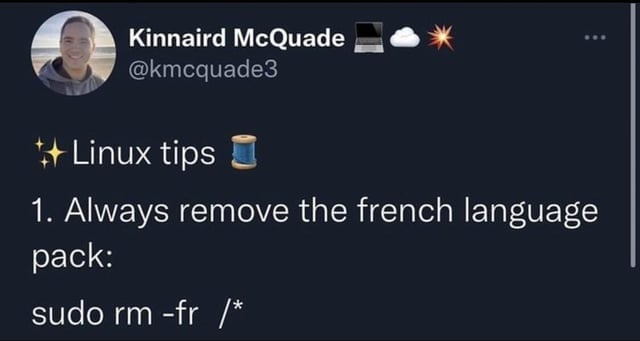this post was submitted on 12 Oct 2023
1222 points (94.5% liked)
linuxmemes
26339 readers
14 users here now
Hint: :q!
Sister communities:
Community rules (click to expand)
1. Follow the site-wide rules
- Instance-wide TOS: https://legal.lemmy.world/tos/
- Lemmy code of conduct: https://join-lemmy.org/docs/code_of_conduct.html
2. Be civil
- Understand the difference between a joke and an insult.
- Do not harrass or attack users for any reason. This includes using blanket terms, like "every user of thing".
- Don't get baited into back-and-forth insults. We are not animals.
- Leave remarks of "peasantry" to the PCMR community. If you dislike an OS/service/application, attack the thing you dislike, not the individuals who use it. Some people may not have a choice.
- Bigotry will not be tolerated.
3. Post Linux-related content
- Including Unix and BSD.
- Non-Linux content is acceptable as long as it makes a reference to Linux. For example, the poorly made mockery of
sudoin Windows. - No porn, no politics, no trolling or ragebaiting.
4. No recent reposts
- Everybody uses Arch btw, can't quit Vim, <loves/tolerates/hates> systemd, and wants to interject for a moment. You can stop now.
5. 🇬🇧 Language/язык/Sprache
- This is primarily an English-speaking community. 🇬🇧🇦🇺🇺🇸
- Comments written in other languages are allowed.
- The substance of a post should be comprehensible for people who only speak English.
- Titles and post bodies written in other languages will be allowed, but only as long as the above rule is observed.
6. (NEW!) Regarding public figures
We all have our opinions, and certain public figures can be divisive. Keep in mind that this is a community for memes and light-hearted fun, not for airing grievances or leveling accusations. - Keep discussions polite and free of disparagement.
- We are never in possession of all of the facts. Defamatory comments will not be tolerated.
- Discussions that get too heated will be locked and offending comments removed.
Please report posts and comments that break these rules!
Important: never execute code or follow advice that you don't understand or can't verify, especially here. The word of the day is credibility. This is a meme community -- even the most helpful comments might just be shitposts that can damage your system. Be aware, be smart, don't remove France.
founded 2 years ago
MODERATORS
you are viewing a single comment's thread
view the rest of the comments
view the rest of the comments

The reason you expect this is because Windows has a file lock behaviour that won’t let you delete a file when it’s in use, in Linux this limitation doesn’t exist.
Raymond Chan, arguably one of the best software engineers in the world, and a Microsoft employee, has repeatedly lamented the near malware like work arounds developers have had to invent to overcome this limitation with uninstallers.
Think about uninstalling a game. You need to run “uninstall.exe” but you don’t want uninstall.exe to exist after you’ve run it… but you can’t delete a file that’s in use. Uninstall.exe will always be in use when you run it….so how do you make it remove itself?
Schedule a task? Side load a process? Inject a process? Many ways…. But most look like malware.
Linux has never suffered this flaw.
This seems like a pretty specific use case, but also pretty common. A system function to delete the file that called it should cover that entirely, but I guess psudo-malware is acceptable?
Pseudo-malware is pretty much the way to go as a developer in my experience.
I believe his suggestion of a javascript file that deletes itself works only works because javascript gets sandboxed and doesn't suffer from Windows "flaw" with file locks.
https://devblogs.microsoft.com/oldnewthing/20230911-00/?p=108749
While Raymond does offer a solution he's also completely side stepping any responsibility on Microsoft's part in creating and perpetuating this problem without offering their own native solution.
That last bit IMO is one reason to argue against him being the best software engineer. He might have the skills, but they are offset by his conflict of interest with MS.
So what is the solution on windows?
Generally the solution is to do something that looks like malware, or use a third party feature that side steps the problem, as happens with javascript.
https://devblogs.microsoft.com/oldnewthing/20230911-00/?p=108749
I made a Batch uninstaller (to one of my other bat scripts I think), and it could remove itself without any problem just with the command "del whateverthenamewas.bat"
Yeah, because the bat file isn't actually running, it's just a list of commands cmd should execute.
Yup, CMD acts as a parser / runtime and the process is bound to the CMD binary, the script file is being run by CMD which keeps a copy of it in its own working memory in RAM